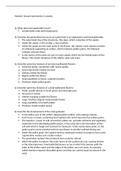Samenvatting
Summary Sexual Reproduction in Plants Flashcards - A-Level Biology
- Vak
- Instelling
Here i have some super detailed flashcards on the module 'Sexual Reproduction in Plants' which i used to achieve an A* in A-Level Biology. The exam board i used was Eduqas/WJEC, however OCR and Eduqas are very similar boards and the flashcards will still be applicable.
[Meer zien]




